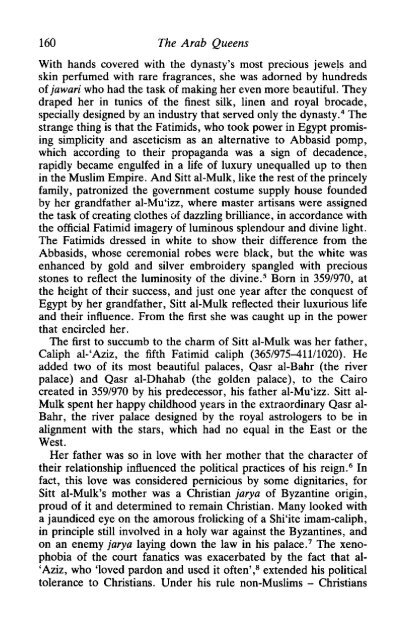Fatima.Mernessi_The-Forgotten-Queens-of-Islam-EN
Fatima.Mernessi_The-Forgotten-Queens-of-Islam-EN
Fatima.Mernessi_The-Forgotten-Queens-of-Islam-EN
You also want an ePaper? Increase the reach of your titles
YUMPU automatically turns print PDFs into web optimized ePapers that Google loves.
160 <strong>The</strong> Arab <strong>Queens</strong><br />
With hands covered with the dynasty's most precious jewels and<br />
skin perfumed with rare fragrances, she was adorned by hundreds<br />
<strong>of</strong>jawawho had the task <strong>of</strong> making her even more beautiful. <strong>The</strong>y<br />
draped her in tunics <strong>of</strong> the finest silk, linen and royal brocade,<br />
specially designed by an industry that served only the dynasty. 4 <strong>The</strong><br />
strange thing is that the Fatimids, who took power in Egypt promising<br />
simplicity and asceticism as an alternative to Abbasid pomp,<br />
which according to their propaganda was a sign <strong>of</strong> decadence,<br />
rapidly became engulfed in a life <strong>of</strong> luxury unequalled up to then<br />
in the Muslim Empire. And Sitt al-Mulk, like the rest <strong>of</strong> the princely<br />
family, patronized the government costume supply house founded<br />
by her grandfather al-Mu'izz, where master artisans were assigned<br />
the task <strong>of</strong> creating clothes <strong>of</strong> dazzling brilliance, in accordance with<br />
the <strong>of</strong>ficial Fatimid imagery <strong>of</strong> luminous splendour and divine light.<br />
<strong>The</strong> Fatimids dressed in white to show their difference from the<br />
Abbasids, whose ceremonial robes were black, but the white was<br />
enhanced by gold and silver embroidery spangled with precious<br />
stones to reflect the luminosity <strong>of</strong> the divine. 5 Born in 359/970, at<br />
the height <strong>of</strong> their success, and just one year after the conquest <strong>of</strong><br />
Egypt by her grandfather, Sitt al-Mulk reflected their luxurious life<br />
and their influence. From the first she was caught up in the power<br />
that encircled her.<br />
<strong>The</strong> first to succumb to the charm <strong>of</strong> Sitt al-Mulk was her father,<br />
Caliph al-'Aziz, the fifth Fatimid caliph (365/975-411/1020). He<br />
added two <strong>of</strong> its most beautiful palaces, Qasr al-Bahr (the river<br />
palace) and Qasr al-Dhahab (the golden palace), to the Cairo<br />
created in 359/970 by his predecessor, his father al-Mu'izz. Sitt al-<br />
Mulk spent her happy childhood years in the extraordinary Qasr al-<br />
Bahr, the river palace designed by the royal astrologers to be in<br />
alignment with the stars, which had no equal in the East or the<br />
West.<br />
Her father was so in love with her mother that the character <strong>of</strong><br />
their relationship influenced the political practices <strong>of</strong> his reign. 6 In<br />
fact, this love was considered pernicious by some dignitaries, for<br />
Sitt al-Mulk's mother was a Christian jarya <strong>of</strong> Byzantine origin,<br />
proud <strong>of</strong> it and determined to remain Christian. Many looked with<br />
a jaundiced eye on the amorous frolicking <strong>of</strong> a Shi'ite imam-caliph,<br />
in principle still involved in a holy war against the Byzantines, and<br />
on an enemy jarya laying down the law in his palace. 7 <strong>The</strong> xenophobia<br />
<strong>of</strong> the court fanatics was exacerbated by the fact that al-<br />
'Aziz, who 'loved pardon and used it <strong>of</strong>ten', 8 extended his political<br />
tolerance to Christians. Under his rule non-Muslims - Christians


